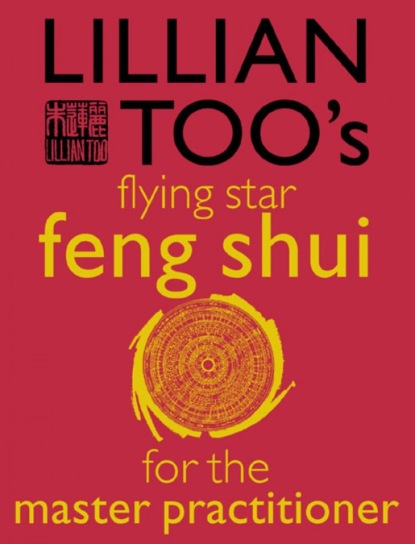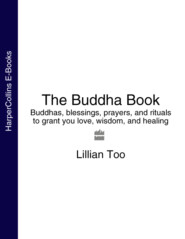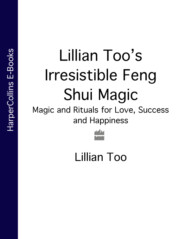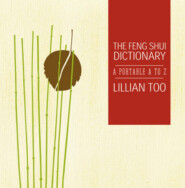По всем вопросам обращайтесь на: info@litportal.ru
(©) 2003-2024.
✖
Lillian Too’s Flying Star Feng Shui For The Master Practitioner
Автор
Год написания книги
2018
Настройки чтения
Размер шрифта
Высота строк
Поля
The seasoned wisdom of thousands of years has gone into the making of the I Ching. It is the most important of China’s ancient books and Chinese philosophy – both Confucianism and Taoism – has its roots in this timeless classic. Known also as the Book of Changes, the I Ching goes back to mythical antiquity. It offers a view on the trinity of heaven, earth, and man, and this trinity underscores a great deal of feng shui theory.
Four legendary personalities are credited with the authorship and evolution of the I Ching: Fu Hsi, King Wen, the Duke of Chou (King Wen’s son), and Confucius – the most famous of China’s great thinkers.
FU HSI, a mythical figure associated with much of China’s ancient wisdom, is said to have observed the heavens and the universe, the changing of the seasons, and the change from night into day, and from his observations invented linear representations which became the three-lined trigrams. The trigrams are the roots of the hexagrams which came later.
KING WEN, the forefather of the Chou dynasty (1105–249 BC), was the man credited with the invention of the 64 hexagrams. He did this by doubling the trigrams from three lines into six lines. King Wen spent a great part of his life in prison before ascending the throne, and during that time he appended judgments to the hexagrams which became the ground work for what was later to evolve into the great wisdom of the I Ching.
THE DUKE OF CHOU, King Wen’s dynamic son, authored the texts which were later to become the individual six changing lines of the hexagrams. He assigned meanings to them as and when they changed from Yin to Yang, thereby manifesting as broken or unbroken lines and vice versa. The Duke of Chou’s contributions were entitled the Changes of Chou, and these subsequently came to be used as oracles. These changes, which are contained in a number of ancient texts, altered the complexion of the I Ching quite substantially and expanded it into a book on divination. This was the status of the book when Confucius come upon it.
CONFUCIUS devoted his life to studying the texts, the judgments, and the images of the I Ching. A great sage, he and his disciples also expanded its scope with a series of masterful commentaries. A great deal of literature about the book flourished during this period, and large portions of this were incorporated into the modern day I Ching.
The I Ching and modern science
There have been major discoveries made concerning the similarities between the lines of the hexagrams and the binary code of numerations. The latter is the foundation of computer technology, so the similarities offer tantalizing potential for speculating on the relationship between the lines and modern technological breakthroughs.
The broken and unbroken lines correspond to the dots and dashes of the binary code exactly. This alone is an amazing discovery and it surely cannot be a coincidence. Scientists have also discovered that the 64 hexagrams of the I Ching correspond exactly to the 64 DNA genetic codes that are the basis of all life on the planet. It is thus possible that in the I Ching lie the hidden meanings to life’s existence.
What has been accepted for hundreds of years, however, is that the I Ching contains many clues to the way energy moves, flows, and accumulates. Hidden within the lines of the hexagrams and their arrangement around a compass of orientations are secrets that explain these flows of energy.
Understanding Yin and Yang
The Chinese have long believed that the creative process goes from one extreme to another, manifesting in endless cycles. So the two extremes of fundamental reality can be expressed as motion (Yang) and quiet (Yin). When one reaches its limit, it becomes the other. So from quiet there is motion, and from motion there is quiet.
It is also written that from this cycle of limits stem the Six, and from the six appear the Five, and then from the five come the Ten Thousand Things. This cryptic sentence is simple to understand when we know what the numbers are referring to. The “Six” refers to the subtle levels of universal Yin and Yang energies. There are three categories that define the qualities of Yin. These are great Yin, balanced Yin, and reducing Yin. Similarly Yang energy can also be classified as great Yang, bright Yang, and diminished Yang. The “Five” are the five elements that express the five manifestations of energy. The Chinese term for energy is chi. These five types of chi are fire, earth, metal, water, and wood. They each have a productive, weakening, or destructive relationship with one of the other elements. Each element also has a Yin as well as a Yang aspect. The “Ten Thousand Things” encompass all the things that make up the material and physical world. The forces of Yin and Yang express the manifest universe from voidness or ultimate nothingness to the material ten thousand things. One becomes two. Motion becomes quiet. Yang becomes Yin and vice versa. This creative process of the universe is illustrated here in sequential order. This is the fundamental origin of how the trigrams and then the hexagrams were discovered.
Yang is described as the vibration, pulse, and movement of the universe – energy rotating, moving, and vibrating at different rates. All of this motion takes place against a background of varying manifestations of Yin. Yin is silence, stillness, non-movement, and quiet. The key to understanding Yin and Yang is to realize that one cannot exist to the exclusion of the other, and that one gives rise to the understanding and manifestation of the other. Yin and Yang are interdependent concepts relative to each other. There is simply no Yang without Yin, and no Yin without Yang. Both must be present, otherwise there is nothing. If you remember this concept alone, you will know about balance, your practice of feng shui will be considerably improved, and your interpretation of the five elements and their symbolic meanings will be incredibly enhanced.
When you understand the concept of Yin and Yang you will understand the theory of relativity and its aggregates. It then becomes easier to understand that everything in the universe exists as interdependent aggregates. Nothing exists of its own accord. When there are no aggregates, things simply cease to exist. Everything exists in relation to something else. It is impossible to completely obliterate either Yin or Yang since this will simply cause both to become nothing.
Yin is said to be denser, less energetic, and more material. Yang is lighter, more energetic, and less dense. In the interplay of Yin and Yang, there are a zillion manifestations and variations. The two forces are primordial and everything on earth is an expression of this interaction between the two forces. Despite this, however, earth is regarded as all Yin and heaven is regarded as all Yang. But the things in heaven are regarded as both Yin and Yang when compared to each other. It is the same with all the things of the earth which can be either Yin or Yang and yet when compared with heaven, things of the earth are all Yin.
The correct appreciation of these two supposedly opposing forces is what gives practitioners of feng shui, Taoism, martial arts and other esoteric practices the real potential to make progress in their practice.
In feng shui a genuine understanding of Yin and Yang forces within any environment is often sufficient to cause good levels of energy to be created. It is the same with the practice of Taoist meditation and in the practice of difficult physical exercises that raise the fire of inner chi. When one understands how Yin and Yang energy flows within the human body one becomes exceedingly healthy. And when one understands their flows in the environment one can arrange things to enjoy exceptional good fortune. Meditation based on a good appreciation of Yin and Yang also creates fertile ground for perfect understanding to grow (referred to as divine realizations by religious meditators).
Yin and Yang cosmology also suggests that idea precedes manifest reality. Nothing exists without it first having been conceived in the mind. So the idea of motion precedes actual motion – just as the idea of quiet precedes actual quiet. The idea comes from the mind, so it is mind that moves energy. It is the mind that makes all things happen. Energy moves the body and galvanizes it into action. Energy is the manifestation of the intangible forces of the world and this can have either a Yin or a Yang aspect. At a practical level, the appreciation of Yin and Yang begins with the ability to know what is Yin and what is Yang, and then from that to appreciate what is deemed to be perfect balance between the two. Identification at the gross levels is not difficult. This refers to knowing that sunlight, bright colors, noise, motion, action, heat, dynamism, and so forth are manifestations of Yang, and moonlight, stillness, darkness, cold, death, quiet, and so on are manifestations of Yin.
What is more difficult to ascertain are the subtle levels of Yin and Yang, or knowing the precise moment when Yin transforms into Yang and vice versa. It is also rather difficult to know when perfect balance of the whole has been achieved. Getting the balance right is something that comes with experience and plenty of practice.
Trigrams and hexagrams
The evolution of trigrams and hexagrams is illustrated on the following page. As can be seen, trigrams are symbolic representations of how Yin and Yang interact and, in the process, manifest in varying densities of energy. These become the four images of old and young Yang, and old and young Yin. By adding a Yin and Yang line above these images the eight trigrams are created. These eight trigrams are then combined with each other to make up the 64 hexagrams. So both feng shui and the I Ching originate from the two energies that make up the universe – Yin and Yang. When you understand this, you will understand the heart of feng shui.
Hexagrams are six-lined symbols that contain surface and veiled meanings that are not immediately obvious. At first reading, these appear terse and abrupt, but sagely wisdom lies just beneath the surface of the words. The I Ching’s hexagrams are each made up of two trigrams, one placed above the other. How trigrams evolved into hexagrams is illustrated in the circular expressions of Yin and Yang shown in The 64 Hexagrams Map (#ulink_1160322e-dbc6-50c6-a5b9-bf9a4c0e94c8).
Trigrams each possess a number equivalent and when these numbers add up to an auspicious combination then the direction indicated by the hexagram is deemed to be auspicious. But in feng shui, the hexagrams of the I Ching that appear on the Luo Pan generally apply to Yin dwellings rather than to Yang houses. Thus when you see hexagrams or two rings of trigrams appearing in a Luo Pan these have been put there to condense the codes for undertaking the feng shui of Yin dwellings i.e. grave sites.
Trigrams, on the other hand, are extremely significant in understanding and interpreting the feng shui of Yang dwellings. Each of the eight trigrams suggests a different symbolism, and their arrangement around the sides of the Pa Kua contain meanings for the specific direction each side represents.
The 64 Hexagrams Map
6. TRIGRAMS AND THEIR MEANINGS (#ulink_e4cb1d70-cb22-5378-914a-b158a864e82e)
Feng shui practitioners of the Compass School frequently make extensive references to trigrams. This is because the meanings of the trigrams offer valuable clues as to how to proceed with arranging a space to maximize feng shui. They not only correspond to compass directions, they are also rich with symbolic meanings. As mentioned earlier they represent one of the elements – expressed either as a soft or a dark aspect – and they possess Yin or Yang connotations. They also signify a specific member of the family.
The meanings of the trigrams and their relationship to each other are significant in expanding the scope of feng shui practice. They offer clues as to what can be “activated” and how their symbolism can be interpreted in the physical realm to bring about auspicious outcomes.
The eight trigrams are Chien, the Creative; Kun, the Receptive; Chen, the Arousing; Sun, the Gentle; Tui, the Joyous; Ken, Keeping Still; Kan, the Abysmal; and Li, the Clinging.
THE TRIGRAM CHIEN, the Creative, comprises three unbroken lines. Its nature is YANG and it is associated with the FATHER, the head of the household, the patriarch, the male paternal. Chien also signifies HEAVEN, the sky, the celestial spheres, strength, activity, power, brightness, bright colors, energy, and perseverance. Chien doubled forms the hexagram of the I Ching whose power is to be interpreted in a dual sense i.e. in terms of the strong creative action of the Deity of the Universe and in terms of the creative action of rulers or leaders in the world of mankind. The element associated with Chien is big METAL, and its symbolic animal is the HORSE – denoting power, endurance, firmness, and strength. Additional symbols of the Creative include jade, which is itself the symbol of purity and firmness; round and circular objects; cold and ice. Its compass direction is South in the Early Heaven arrangement of the Pa Kua, and NORTHWEST in the Later Heaven arrangement. In Yang feng shui, the direction of Chien is also northwest, and its number is 6.
THE TRIGRAM KUN, the Receptive, is made up of three broken lines. The broken lines represent the dark, yielding, receptive, primal power of YIN. The attributes of this trigram are associated with the MOTHER, the female; maternal and devoted. Its image is the whole EARTH, which knows no partiality. The animal symbolizing Kun is the COW with a calf, thereby symbolizing fertility. Kun is the perfect complement of Chien, the Creative (complement and not opposite because the Receptive does not combat the Creative but rather completes it). Kun signifies NATURE, in contrast to spirit, earth in contrast to heaven, space against time, the female maternal as against the male paternal.
In the interpretations of Kun in respect of the destiny of mankind, and when applied to human affairs, the relationship between Chien and Kun refers not only to the man-woman relationship but also to that of the prince and minister, father and son, employer and employee.
According to the I Ching’s commentary, Kun the Receptive must be activated and led by Chien the Creative if it is to maximize its benevolent essence. The corresponding compass direction of Kun is north in the Early Heaven arrangement, but in Yang feng shui and the Later Heaven arrangement it is the SOUTHWEST which represents Kun. Its element is EARTH and its number is 2.
THE TRIGRAM CHEN, the Arousing, is made up of two broken Yin lines above an unbroken Yang line. The trigram represents the ELDEST SON and is often associated with movement and decision-making, vehemence and shock. It is symbolized by the DRAGON, which, rising out from the depths, soars magnificently up into the stormy skies. This is represented by a single strong line pushing upward below the two yielding lines. This trigram is represented by a dark yellow color, spreading outwards, which suggests the luxuriant growth of spring that covers the earth with a garment of plants. In the I Ching, the doubling of this trigram forms the hexagram Chen, which is described as “… shock, arousing fear, which in turn makes one cautious, and caution brings good fortune … a symbol of inner calm in the midst of the storm of outer movement.”
Chen also signifies thunder, “the kind which terrifies for miles around, a symbol of a mighty ruler who knows how to make himself respected yet is careful and exact in the smallest detail.” Chen is placed northeast in the Early Heaven arrangement and east in the Later Heaven sequence. In Yang feng shui we therefore use EAST as the direction that signifies Chen. Its element is big WOOD and its number is 3.
THE TRIGRAM SUN, the Gentle, is formed by two unbroken Yang lines above a broken Yin line. This trigram represents the ELDEST DAUGHTER and its attribute is summed up in the word “penetrating.” The gentle is small wood, it is the wind, it is indecision.
The COCKEREL, whose voice pierces the still morning air, symbolizes it. Among men, it means those with broad foreheads, those with much white in their eyes; it means those close to making gains, so that in the market they get threefold value. Sun is sometimes interpreted as a sign of vehemence. Sun also represents white and whiteness, which is sometimes regarded as the color of the Yin principle and sometimes as the Yang. Here Yin is in the lowest place at the beginning. Sun is placed southwest in the Early Heaven arrangement and southeast in the Later Heaven arrangement. So in Yang feng shui we use SOUTHEAST to represent Sun. Its element is small WOOD and its number is 4.
THE TRIGRAM TUI, the Joyous, comprises one broken Yin line above two unbroken Yang lines. The two Yang lines are considered the rulers of the trigram, although they are incapable of acting as governing rulers. Tui represents joy, happiness, and the YOUNGEST DAUGHTER. Tui is the LAKE, which rejoices and refreshes all living things. Furthermore Tui is the mouth; when human beings give joy to one another through their feelings, it is manifested by the mouth. A Yin line above two Yang lines illustrates how the two principles give joy to each other and are manifested outwardly. Tui also means dropping off and bursting open. It is the concubine, an association derived from the youngest daughter connections. It is the sheep, which is outwardly weak and inwardly stubborn, as suggested by the form of the trigram. In the Early Heaven arrangement, the trigram is placed southeast, but in the Later Heaven arrangement it is placed WEST, so this is the direction which is used to signify Tui in the application of formulas for Yang dwellings. Its element is small METAL and its number is 7.
THE TRIGRAM KEN, Keeping Still, comprises an unbroken Yang line above two broken Yin lines. Ken represents the YOUNGEST SON in the family. The trigram literally means standing stiff, a situation exemplified by the image of the mountain. Ken is the MOUNTAIN, a symbol of mysterious significance. Here, in the deep hidden stillness, the end of everything is joined to make a new beginning. Death and life, dying and resurrection – these are thoughts awakened by the transition from an old year to a new year. Ken thus signifies a time of solitude that is also the link between an ending and a beginning.
The element signified by Ken is small EARTH. Under the Early Heaven arrangement of the trigrams, it is placed in the northwest. Under the Later Heaven arrangement Ken is northeast, so in Yang feng shui Ken is represented by the NORHTEAST. Its element is small EARTH and its number is 8.
THE TRIGRAM KAN, the Abysmal, is made up of one unbroken Yang line sandwiched between two broken Yin lines. Kan represents the MIDDLE SON. It is symbolized by WINTER. Kan signifies pearls, craftiness, and hidden things. It is also considered as a symbol of danger and melancholia because one (strong) Yang line is hemmed in by two (weak) Yin lines. Kan is often referred to as the trigram which suggests toil. Unlike the other trigrams, Kan represents work. It is not a happy trigram.
The symbolic color of Kan is red to resemble the fluid of the body – blood. Kan was originally placed west in the Early Heaven arrangement, but was moved to the north under the Later Heaven arrangement. Thus in Yang-dwelling feng shui, Kan is signified by the direction NORTH. Its element is WATER and its number is 1.
THE TRIGRAM LI, the Clinging, is made up of one broken Yin line hemmed in by two strong Yang lines. Li is LIGHTNING, and represents the MIDDLE DAUGHTER. Li is also represented by the sun, brightness, heat, and dryness. The character of the trigram suggests something firm on the outside but hollow, weak, and yielding within. This trigram strongly implies dependence, but the kind of dependence which is positive and nourishing – as when the plant “clings” to the soil and grows or when “the sun and the moon attain their brightness by clinging to heaven.” The yielding element in Li is the central line, hence its image is of a strong yet docile type of cow.
Its element is FIRE and as fire flames upwards, the phrase “that which is bright rises” applies to Li. In the spiritual or divination sense, the brightness of this trigram offers the potential (if the illumination of the brightness stays consistent) for its light to “illuminate” the world. Li occupies the east in the Early Heaven arrangement, but under the Later Heaven arrangement it is in the south, which represents the summer sun that illuminates all earthly things. So in applying the formulas for Yang dwellings we use SOUTH as the direction of Li. Its number is 9.
7. THE TWO TRIGRAM ARRANGEMENTS (#ulink_2e660f1c-49a9-51e2-a752-e352d7bedec9)
The eight trigrams are the root symbols of the I Ching’s 64 hexagrams. Each trigram is a combination of three straight lines that are either broken or unbroken – much like dots and dashes in a binary code. Trigrams collectively symbolize a trinity of world principles recognized as the subject (man), the object having form (earth), and the content (heaven). The bottom line is earth, the middle is man, and the top line is heaven.
A significant feature of the trigrams is that they transform, and in doing so create new aspects. This is why we have two arrangements of the trigrams – the Early Heaven and the Later Heaven arrangement thus producing two Pa Kuas – the Yin and Yang Pa Kua. In the Early Heaven arrangement the transformations are expressed as “Heaven and Earth determining the directions” – signified by Chien and Kun; “Mountain and Lake uniting” (Ken and Tui); “Thunder and Wind arousing each other” (Chen and Sun); and as “Water and Fire (Kan and Li) not combating” each other. This summary of the trigram relationships reflects their arrangement in the Early Heaven Pa Kua. These descriptions feature in the application of Yin feng shui of grave sites.
In the Later Heaven arrangement, the trigrams express a seasonal cyclical relationship so that their place in the Pa Kua changes. For feng shui purposes it is very significant to note how these trigrams change locations/directions. This movement of places suggest implications on the luck on houses as a result of the way waters (i.e. rivers) flow towards the house/building from one direction and exit in another direction. The same interpretation can also be analyzed with regard to roads that are in the vicinity of your home. Generally when water or roads flow towards the home from an Early Heaven direction (EHD) and flow out in a Later Heaven direction (LHD), the water reflects luck coming from heaven flowing to earth and is auspicious for Yang houses. Moving in the other direction is not auspicious and suggests illness, death, and loss. So note the following summary of the EHD and LHD of the directions based on the trigram transformations of the two Pa Kuas. When roads or rivers near your home flow in the following way they are said to be auspicious for the home.
The trigram Chien moves from south (in the Early Heaven arrangement) to the northwest (in the Later Heaven arrangement), so when roads or rivers come towards the home from the south and move away in a northwesterly direction the road is auspicious and benefits the father of the household.










